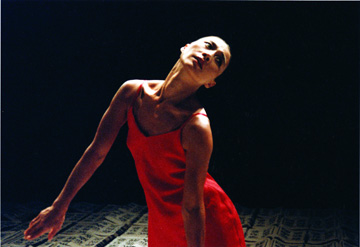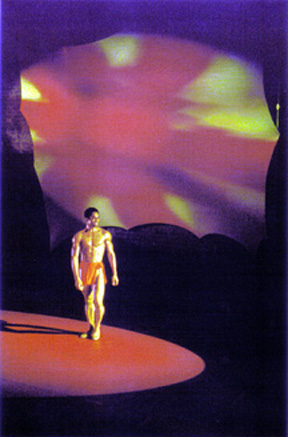The Old and the New
Fall Fall for Dance Festival
City Center
New York, NY
September 30, October 1, 2 & 3, 2004
By
Susan Reiter
copyright
© 2004 by Susan
Reiter
published October 5, 2004

One of the intentions behind City Center executive director Arlene Shuler's concept was to bring in new—hopefully younger—audiences to dance, and certainly that seemed to be happening. (The loud, funky music the DJs spun in the specially designed Festival Lounge created in an adjacent atrium certainly seemed aimed at that segment of the audience.) But for those of us neither new to dance or all that young, Fall for Dance evoked memories of an earlier period of the New York dance scene.
Certainly it served a similar function as the now-long-ago and still-missed annual dance festival held for two weeks in late summer at Central Park's Delacorte Theater. There, too, a veritable smorgasbord of dance was offered, on mixed programs. Since tickets were free, many people who might not otherwise venture into a dance performance came to see what was going on. It was a place where discoveries were made, longstanding loyalties to various artists and companies were initiated, and dancers performed for a truly democratic and varied audience, not just the dance aficionados.
The new festival's energy and availability of cheap tickets was also reminiscent of a time when the Joffrey had two seasons a year at City Center, and it also played host to Alvin Ailey, Martha Graham and others, and tickets up at the top cost $2. Now, the second balcony is rarely opened—only for Alvin Ailey's season and the popular Encores presentations. Back then, City Center was where one could easily obtain a low-priced, eclectic dance education.
The Fall for Dance programming choices were savvy and made for evenings that were always interesting and for the most part broadly representative of what's available in dance today. In some cases there were intriguing resonances and connections between works on a given program. On Wednesday, Martha Graham's 1958 "Embattled Garden," featuring Spanish composer Carlos Surinach's music and suggestions of Flamenco costuming in the women's ruffled skirts and preening manner. Sultry passions seethed within the fierce foursome that populates this troubled Eden, and then one could see truly Flamenco fire in the performance of Noche Flamenca's Soledad Barrio, whose extended "Solea" closed the program.

It was interesting to observe on sequential evenings two works in which Paul Taylor once danced—the Graham piece and his solo from Balanchine's 1959 "Episodes," and then the next night see Mr. Taylor's own work, "Promethean Fire," which becomes more remarkable more on each viewing. There is so much eloquent grandeur within this vortex of urgency, mournfulness and resolve; it is in every way a big, important work, yet Mr. Taylor says it all within less than 20 minutes Like all truly great works, it wastes not a moment and says all that needs to be said.

Another highlight was the feisty, revved-up hip-hop moves that Victor Quijada worked into excerpts from "Elastic Perspectives," his rapid-fire choreography to several classical music warhorses (Prokofiev's ballroom music form "Romeo and Juliet," the drinking aria from Verdi's "La Traviata," and Vivaldi's "The Four Seasons). The five dancers from his young Montreal-based troupe, Rubberbandance, seemed to be kick-boxing their way through the Prokofiev, their fierceness perfectly matching the somber aggression of the score. Mr. Quijada is perhaps over-enthusiastic about having his dancers pull out all the virtuosic stops, but he's clearly onto something exciting with his juicy blend of modern and ballet moves with hip-hop, and the audience gave Rubberbandance one of the most vociferous ovations of the week. (Other major contenders in terms of audience response were Boston Ballet's performance of Jorma Elo's "Plan to B" and Bill T. Jones/Arnie Zane Company's dozens of dancers (include a mother with her small daughter) making their way across the stage in the buff in "Continuous Replay."
The serenely gorgeous performance of "Diana and Acteon" by Paloma Herrera and José Manuel Carreño on closing night has to be counted as one of the highlights, as both dancers were clearly inspired by the occasion to dance with special verve. Both have modest demeanors in comparison with some of their colleagues, and let the dancing, rather than mannerisms create the excitement. Ms. Herrera unspooled gorgeous pirouette sequences without apparent effort, and Mr. Carreno once again demonstrated that he is one of the few who can maintain dignity in this scanty tarzan-like costume, his brawny leaps and revoltades cleaving the space with power and not a trace of hokiness.
A pleasant surprise was how beautiful Annie-B Parson's "City of Brides," an offbeat, intriguing little ritual for five doll-like women, looked on this stage. The potent pictorial sense always in evidence in the work she and Paul Lazar create for Big Dance Theatre played a strong role here, as this cluster of inscrutable yet endearing figures in shiny wide boldly colored smocks proceeded through their mysterious mission, made just that extra but more unsettling by the hauntingly insistent Richard Einhorn score.
Most of the week's music was recorded, necessarily, but there was live accompaniment for one work on each program. Of these, the absolutely sensational, tireless drummers for Batoto Yetu (Saturday) became one of the week's memorable highlights.

The roster of performers could be divided into two basic categories. There were companies that perform (or used to perform) regularly at City Center—Graham, Taylor, ABT, Dance Theatre of Harlem (whose incisive "Agon" performance on opening night was a bittersweet signoff as they head into an extended hiatus), Merce Cunningham and Trisha Brown. There were established performers—Garth Fagan, Eiko and Koma, Ballet Hispanico, Ronald K. Brown/Evidence—who have major New York presences but for whom City Center was a new venue. There were various ethnic ensembles who contributed a sampling of Indian, African and Sufi dance. And then there were accomplished "downtown" artists with their own burgeoning reputations (and loyal admirers who clearly found their way there to cheer them on this occasion) for whom City Center represented a far larger venue and audience than they have ever had before. Of these, the two-woman trapeze act performed by Lava, the intrepid female circus-skills troupe came across remarkably well. A demonstration of strength and support that quietly conveyed a strong feminist message but also mesmerized with its smooth display of sudden drops and lifts, it was artfully enhanced by bold lighting that echoed the bright colors of the women's costumes and by the pulsating, well-chosen music.
One can imagine only good things flowing from this lively, enriching week. Piles of brochures for the participating companies (and others) were available in the popular Lounge, and hopefully those inspired by something(s) they saw this week will take the next step and attend other dance performances. The enthusiastic, hungry response of ticket buyers will presumably insure an annual repeat, with the generous funders who subsidized the oh-so-low ticket price feeling inspired to continue their support, and others hopefully coming on board to join the party. In terms of performers, can we dream of perhaps seeing New York City Ballet (whose California tour made them unavailable for this year's festival) back on the City Center stage, and possibly some representatives of the west coast and other parts of the country being included?
Photos:
Front page: Ballet Hispanico. Photo: Andrew Unangst.
First: Paul Taylor's "Promethean Fire." Lisa Viola, Patrick
Corbin. Photo: Lois Greenfield.
Second: Yin-Mei. Photo: Gemma Comas.
Third: Peter Boal in Twyla Tharp's "Pergolesi."
Photo: Rosalie O'Connor.
Fourth: Desmond Richardson.
www.danceviewtimes.com
Volume 2, No. 37
October 4, 2004
Copyright
©2004 by Susan Reiter
|
|
|